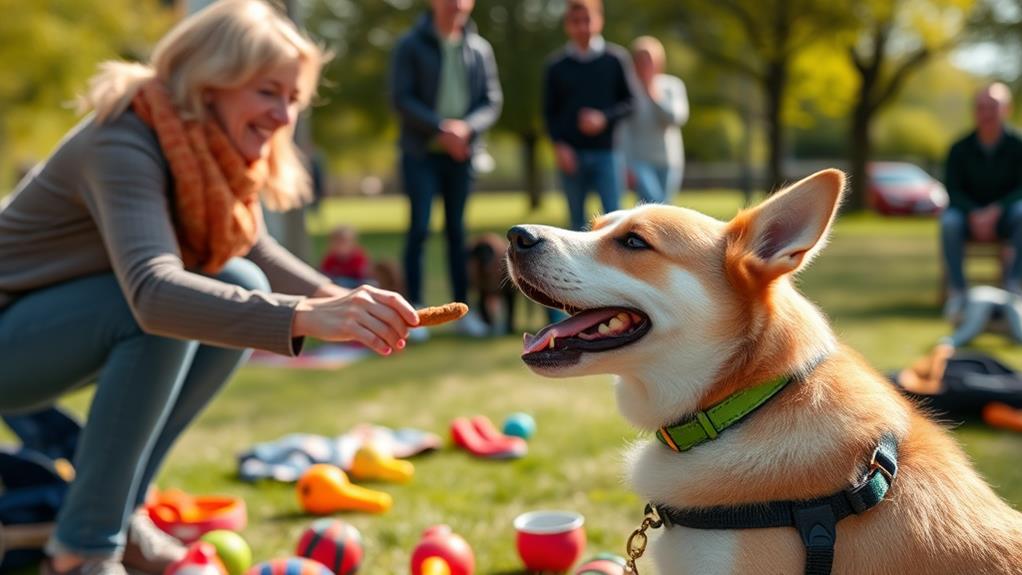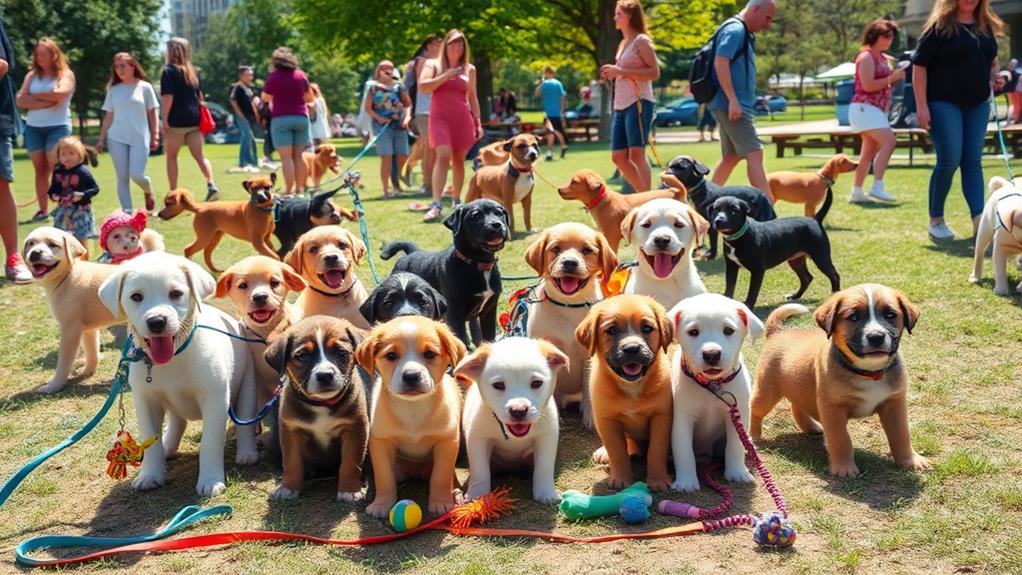Gain access to your dog's potential with these 10 training tips from the Reddit community. Start with basic commands in a quiet space, using a firm voice and consistency. Reward good behaviors with treats and praise to build trust. Be consistent across all household members and keep training sessions short—about 5-10 minutes works best. Socialize your dog early to expose them to different environments. Set realistic goals tailored to your dog's breed and temperament, and don't hesitate to seek professional help if needed. You'll find even more valuable insights to enhance your training journey as you explore further.
Start With Basic Commands

When you begin training your dog, it's vital to start with basic commands like "sit," "stay," and "come." These foundational commands not only establish a line of communication between you and your pet but also help in building trust and respect. Mastering these commands sets the stage for more advanced training and helps your dog understand what you expect from them.
To start, choose a quiet space free from distractions. This allows your dog to focus on you and the task at hand. Use a clear, firm voice when giving commands, and make sure to be consistent with your wording. For example, always say "sit" rather than mixing it up with "sit down."
It's also important to be patient. If your dog doesn't respond immediately, don't get frustrated. Instead, gently guide them into the desired position. Repeating the command and demonstrating the action can also help. Remember, your dog is learning to interpret your cues, so clarity is key.
Once your dog masters these commands, you'll notice improved behavior and a stronger bond between you both, making training a more enjoyable experience for everyone involved.
Use Positive Reinforcement

Using positive reinforcement is one of the most effective ways to train your dog and build a lasting bond. This method focuses on rewarding your dog for desired behaviors, making training a fun and engaging experience for both of you. By incorporating treats, praise, and playtime, you encourage your dog to repeat those good behaviors.
Joyful wagging tails when your dog realizes they've done something right.
Unforgettable moments of connection as you celebrate their achievements together.
Increased trust as your dog learns that training is a positive experience.
Strengthened loyalty, knowing your dog feels loved and appreciated.
Be Consistent With Training

Consistency is key in dog training, as it helps your furry friend understand what's expected of them. When you establish clear commands and rules, your dog will learn faster and feel more secure. Make sure everyone in your household uses the same cues and guidelines. If one person allows jumping on the couch while another doesn't, your dog will become confused.
Set a routine for training sessions. Short, frequent sessions are more effective than long, infrequent ones. Aim for 5 to 10 minutes a day, focusing on one command at a time. Repetition reinforces learning, and your dog will appreciate the predictability.
Don't forget to be consistent with rewards and corrections. If your dog performs a command correctly, reward them immediately. This reinforces the behavior and helps them associate the command with a positive outcome. Conversely, if they misbehave, respond consistently without anger or frustration. Using a calm voice and clear body language helps convey your expectations.
Socialize Your Dog Early

Socializing your dog early is crucial for their development and well-being. The more experiences your pup has with different environments, people, and other animals, the more confident and well-adjusted they'll become. This process helps prevent behavioral issues down the line, making your life—and theirs—much easier.
Reduces fear: Exposing your puppy to various stimuli helps them feel secure and less anxious in new situations.
Encourages positive behaviors: Well-socialized dogs are more likely to exhibit friendly behavior toward others, reducing the chances of aggression.
Builds trust: Regular interactions help strengthen the bond between you and your dog, fostering a trusting relationship.
Enhances training: A dog that's comfortable in diverse environments is more likely to focus during training sessions and respond positively to commands.
Start socializing your dog as soon as you bring them home. Introduce them to different people, sights, and sounds. Attend puppy classes, go for walks in busy areas, and invite friends over. The more exposure your dog has, the better equipped they'll be to handle life's challenges.
Keep Training Sessions Short

After your dog has become comfortable in various social situations, it's time to focus on effective training techniques. One of the most essential tips is to keep your training sessions short. Dogs, especially puppies, have limited attention spans, so aim for 5 to 10-minute sessions. This way, you'll keep their focus sharp and avoid overwhelming them.
Short sessions can be more effective than longer ones. You want your dog to associate training with positive experiences, and if they start to lose interest, they may become frustrated or bored. By keeping things brief, you can maintain their enthusiasm and willingness to learn.
Also, consider spreading these short sessions throughout the day rather than cramming them all into one long session. This approach reinforces learning and gives your dog time to process what they've learned. You'll find that your dog will respond better when they're engaged and enthusiastic about training.
Lastly, remember to end each session on a positive note. Celebrate small victories with praise or treats, ensuring your dog looks forward to the next training opportunity. Keeping sessions short and enjoyable will set the foundation for a well-trained companion.
Incorporate Play Into Training

Incorporating play into your dog training can make the experience more enjoyable and effective for both of you. When you blend learning with fun, your dog stays engaged and enthusiastic to participate. Training doesn't have to be a chore; it can be an exciting adventure that strengthens your bond.
Use toys as rewards: Instead of just treats, consider using your dog's favorite toy as a reward for good behavior. This keeps them motivated and thrilled.
Incorporate games: Turn commands into games, like "fetch" for "come" or "hide and seek" for "stay." This adds an element of fun and challenge.
Mix training with playtime: Start with a few training commands, then shift to free play. This way, your dog associates training with a playful atmosphere.
Celebrate successes: Always celebrate small victories with playful interactions, like a quick game of tug-of-war or a joyful dance together.
Understand Your Dog's Body Language

Understanding your dog's body language is key to effective training and communication. Your dog communicates through various signals, and recognizing these can enhance your bond and training success. Pay attention to their ears, tail, and posture. For example, if your dog's ears are back and their body is low, they might feel scared or submissive. Conversely, if they're standing tall with wagging tails, they're likely happy and confident.
Tail wagging can vary in meaning. A slow wag could indicate uncertainty, while a fast wag often shows excitement. Keep an eye on their eyes, too. Soft, relaxed eyes suggest comfort, while wide, dilated pupils may indicate fear or anxiety.
Don't forget about mouth movements. A relaxed mouth means your dog is at ease, while a closed mouth or lip licking can indicate stress.
When training, observe these signals to adjust your approach. If your dog seems overwhelmed, consider taking a break. By tuning in to your dog's body language, you can create a positive training environment and foster mutual understanding. With practice, you'll become fluent in your dog's unique language, strengthening your relationship and improving training results.
Avoid Harsh Punishments

Harsh punishments can do more harm than good in dog training. Instead of teaching your dog what to do, they often lead to fear, anxiety, and confusion. When you resort to yelling, hitting, or using shock collars, you risk damaging the bond you share with your furry friend. Dogs learn best in a positive environment where they feel safe and secure.
Consider these emotional impacts of harsh punishments:
- Fear: Dogs may become fearful of you, leading to trust issues.
- Aggression: A frightened dog might respond with aggression, escalating the problem.
- Anxiety: Constant punishment can cause anxiety, resulting in behavioral issues.
- Confusion: Your dog may not understand what they did wrong, making training ineffective.
Instead of harsh tactics, focus on positive reinforcement. Reward good behavior with treats, praise, or playtime. This approach fosters a loving relationship and encourages your dog to learn and grow. Remember, training should be a bonding experience, not a battle. With patience and kindness, you'll see better results and a happier, more confident dog.
Set Realistic Goals

Setting realistic goals is essential for effective dog training and helps keep you motivated throughout the process. When you set achievable objectives, you create a clear path for you and your dog to follow. Start by identifying specific behaviors you want to train, like sit, stay, or come. Break these down into smaller steps, so you can celebrate progress along the way.
For example, if you want your dog to master the "stay" command, don't expect them to hold it for long periods right away. Start with just a few seconds and gradually increase the duration as they succeed. This approach not only builds your dog's confidence but also reinforces their understanding of what you expect.
It's also important to contemplate your dog's age, breed, and temperament when setting goals. Some dogs may learn quickly, while others might take their time. Tailoring your expectations to their unique personality fosters a positive training experience.
Regularly assess your goals and be ready to adjust them if necessary. Remember, training is a journey, and celebrating small victories keeps you both engaged and excited about learning together.
Seek Help When Needed

Even with realistic goals in place, you might encounter challenges during your dog training journey. It's completely normal to feel overwhelmed or frustrated at times. Remember, seeking help is a sign of strength, not weakness. Whether you're dealing with stubborn behaviors or just need a fresh perspective, reaching out can make all the difference.
Expert guidance: Professional trainers can provide tailored advice and techniques that suit your dog's unique personality.
Supportive community: Engaging with fellow dog owners can offer encouragement and share experiences that resonate with your struggles.
Avoiding burnout: Taking a break and getting help can prevent you from feeling drained and losing motivation.
Building confidence: Working with a professional can boost your confidence, helping you feel more capable as a trainer.
Don't hesitate to reach out for help when you need it. Whether it's a trainer, a friend, or online forums, there's a wealth of support available to guide you through any rough patches. Your dog's training journey is a partnership, and you don't have to navigate it alone.
Frequently Asked Questions
How Do I Choose the Right Training Method for My Dog?
To choose the right training method for your dog, consider its personality, age, and specific needs. Research various techniques, and don't hesitate to mix approaches. Trust your instincts, and stay patient throughout the process.
What Age Is Ideal to Start Training My Puppy?
The ideal age to start training your puppy is around eight weeks. At this age, they're most receptive to learning. Start with basic commands and socialization; it'll set a solid foundation for their development.
How Can I Handle Stubborn or Unresponsive Dogs During Training?
Training a stubborn dog's like trying to untangle a knot; patience is key. Stay calm, use positive reinforcement, and break tasks into smaller steps. Consistency and understanding their triggers will help you connect and succeed.
Are There Specific Breeds That Are Easier or Harder to Train?
Some breeds, like Border Collies and Poodles, are easier to train due to their intelligence and keenness to please. Others, like Bulldogs, may be more stubborn. Understanding each breed's traits can help you tailor your approach.
What Are Common Mistakes to Avoid While Training My Dog?
Training a dog's like building a bridge; you need solid foundations. Avoid common mistakes like inconsistency, harsh corrections, and unrealistic expectations. Stay patient, use positive reinforcement, and remember, it's a journey, not a race.
Conclusion
Just like a gardener tends to their plants with care and patience, nurturing your dog's training journey can yield a flourishing bond. By embracing these tips, you're planting seeds of understanding and trust that will grow strong over time. Remember, every dog blooms at their own pace, so celebrate the little victories along the way. With love, consistency, and a sprinkle of patience, your efforts will blossom into a well-behaved companion who brings joy to your life.



